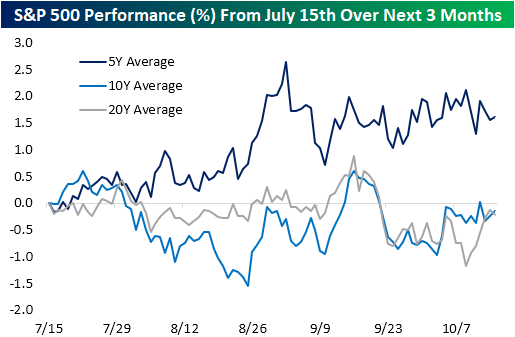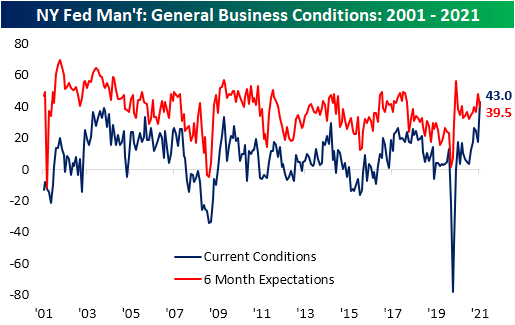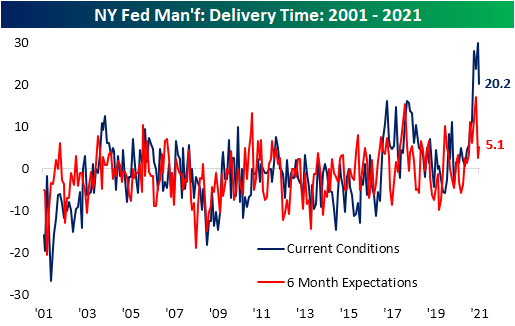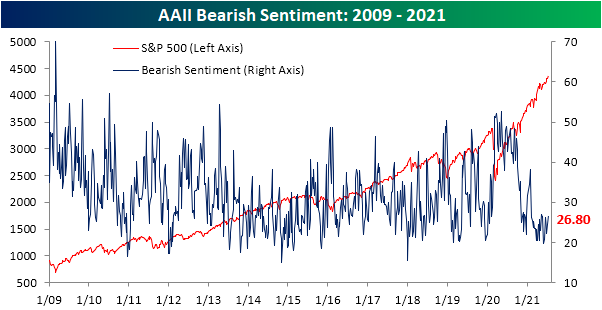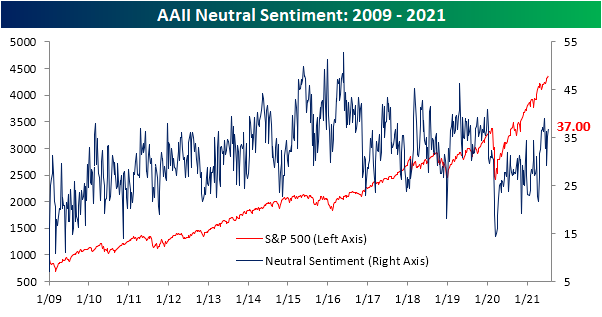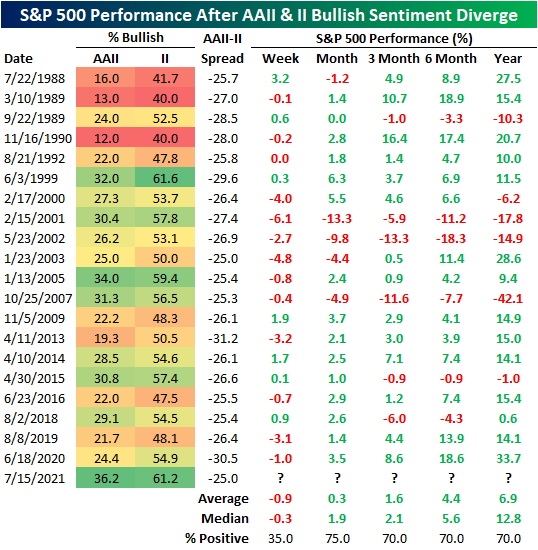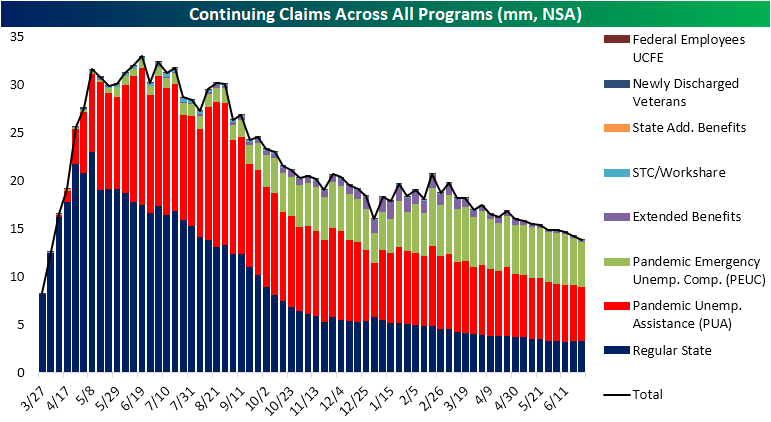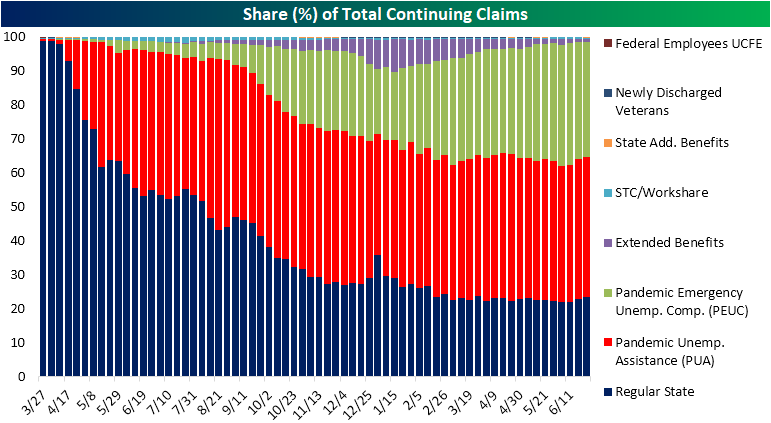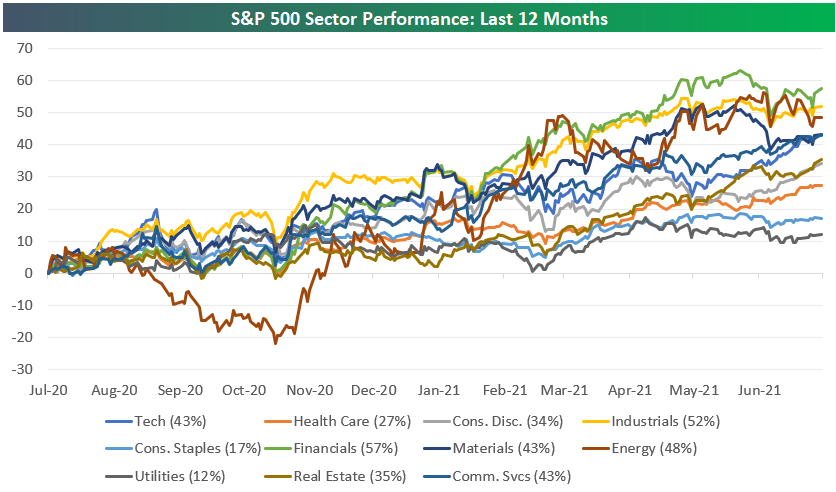Bespoke Brunch Reads: 7/18/21
Welcome to Bespoke Brunch Reads — a linkfest of the favorite things we read over the past week. The links are mostly market related, but there are some other interesting subjects covered as well. We hope you enjoy the food for thought as a supplement to the research we provide you during the week.
While you’re here, join Bespoke Premium with a 30-day free trial!
Labor Markets
The CFO Survey: Data & Results – Q2 2021 (Richmond Fed)
While CFOs reported a huge uptick in concern over labor quality and availability, optimism over their specific company’s prospects hit the second-highest level ever and general confidence about the trajectory of the US economy was improved as well. [Link]
McDonald’s Owners Offer Tuition, Child Care to Lure Burger Flippers by Heather Haddon (WSJ)
Franchisees are expanding their benefit packages in order to hire workers, with higher wages, paid time off, and tuition coverage also being offered in order to attract workers amidst and extremely tight labor market for restaurant workers. [Link; paywall]
Environment
A “wobble” in the moon’s orbit may lead to record floods on Earth by Sophie Lewis (MSN)
In addition to rising seas thanks to higher temperatures, flooding will worsen over the next couple of decades as a wobble in the moon’s orbit drives unusually high tides that may overwhelm costs even without a storm surge or higher sea level. [Link]
People dumped their pets into lakes, officials say. Now football-size goldfish are taking over. by Reis Thebault (WaPo)
While goldfish in bowls tend to be pretty small, when released into the environment they can grow to impressively large sizes while also badly disrupting the ecosystems they’re released in to. [Link; soft paywall]
Have you ever wondered why we don’t find fossils in the Appalachian mountains? The truth is, we do, they’re just not the kind of fossils you might think of—there are no mammals, no dinosaurs, no reptiles. There’s something else entirely. by Alex (ThreadReader)
A fascinating read on the absolutely ancient Appalachians, which were produced through multiple continental collisions and are part of the same mountain range that covered northern Britain and Scandinavian. [Link]
Tight Supply
Here’s Who Will Be Left Behind in the Housing Boom by Ali Wolf (NYT)
With out-of-town buyers that have much higher incomes than locals fueling the housing boom since COVID hit, current residents are unable to compete. The result is a huge shift in the housing market. [Link; soft paywall]
Build-to-Order Gains Momentum at Long Last by Steve Finlay (Wards Auto)
Traditionally, automakers have built inventory for consumers to purchase on the spot. But tight inventories and the success of non-dealer models like Tesla have led to shifts in the traditional approach. [Link]
Infrastructure
China Buys Friends With Ports and Roads. Now the U.S. Is Trying to Compete. by Stu Woo and Daniel Michaels (WSJ)
In response to China’s soft power “Belt & Road” initiative, the US is ramping up investments in various types of infrastructure around the world as a way to counter the Chinese effort to win friends with cheap loans and direct investment in ports, communications, and railways. [Link; paywall]
Investing
Treasury Wants Large Holders of 2020 Note to Identify Themselves by Liz McCormick (Bloomberg)
A 2020 ten year note issue may have had extreme concentration, leading the Treasury to demand large holders to identify themselves, part of its regular efforts to ensure nobody corners the market in a given bond. [Link; soft paywall]
Robinhood, Others Upend Rules for Early IPO Trading by Corrie Driebusch (WSJ)
Rather than being forced to hold for the traditional six months, early investors in Robinhood will be able to sell 15% of their holdings immediately and 15% three months later with full restrictions lifted after six months as is typical. [Link; paywall]
Wall Street Has Surrendered to the $500 Billion ETF Rush by Claire Ballentine and Francesca Maglione (Bloomberg)
We’re only a couple of days in to the second half, but ETFs are on track to break the $497bn record inflows ETFs recorded in 2020; that means the full annual flow total is likely to be substantially higher. [Link; soft paywall]
Overdoses
US overdose deaths hit record 93K in pandemic last year, a 29% increase (Associated Press/NYP)
Exploding prevalence of fentanyl and policy responses to the pandemic drove a huge increase in overdoses last year. [Link; auto-playing video]
Read Bespoke’s most actionable market research by joining Bespoke Premium today! Get started here.
Have a great weekend!
Seasonal Summer Slump
Taking a look at our Seasonality Tool, it is hard to find a day in the year that will give a weaker reading for the one month to three month periods. As shown in the snapshot of the tool below, over the past decade, the one month period from mid-July has a median loss of 0.34%. That stands in the 13th percentile of all periods of the year. Meanwhile, three month performance ranks even weaker in the bottom 2% of all periods with a median decline of 1.19%.
To show this in another light, in the chart below we show the average 3 month forward performance over the past 30 years for each calendar day of the year. July is the only major period of the year in which the forward 3-month performance consistently leans negative.
While over the long term mid-July and the next few months have been one of the weaker periods of the year, more recently things have been a bit better. In the chart below, we show the S&P 500’s average performance from July 15th out over the next three months. While the 10 and 20-year averages show the S&P 500 is typically flat or slightly lower through the summer and early fall, the index has actually on average trended higher over the past five years. In other words, that seasonal weakness has been less evident in recent years. Click here to view Bespoke’s premium membership options.
Bespoke’s Morning Lineup – 7/16/21 – Nine Would Be Fine
See what’s driving market performance around the world in today’s Morning Lineup. Bespoke’s Morning Lineup is the best way to start your trading day. Read it now by starting a two-week free trial to Bespoke Premium. CLICK HERE to learn more and start your free trial.
“The first principle is that you must not fool yourself, and you are the easier person to fool.” – Richard Feynman
Futures are higher this morning ahead of Retail Sales, Business Inventories, and a preliminary read on Michigan Confidence. On the Retail Sales front, both the headline and ex Autos readings came in significantly ahead of forecasts.
Summer Fridays are typically slow, but one area of excitement will be the Nasdaq 100 where the index needs to close about 35 points higher today in order to extend its current weekly winning streak to nine. Based on where futures are currently trading, the index should be in the green for the week to start the trading day, but where it finishes will be more important. Whether the streak ends at eight or extends to nine, though, it would still be the longest weekly winning streak for the index since the first half of 2019.
Read today’s Morning Lineup for a recap of all the major market news and events from around the world, economic data out of Asia and Europe, the latest US and international COVID trends including our vaccination trackers, and much more.
The picture for the three major indices shows vastly different pictures depending on which index you look at. Starting with the Russell 2000, it has been a major laggard and yesterday was on pace to close more than 1.5% lower for the third consecutive day, but a late-day bounce erased more than two-thirds of the decline. As weak as the Russell has been lately, the longer-term chart is far from breaking down as it remains stuck in a range after surging in late 2020 and into early 2021.
For large-cap stocks, the picture looks much different. Both the Nasdaq 100 and S&P 500 hit record highs earlier this week but have been wobbling in the last few days. While the Russell 2000 trades in oversold territory, the large-cap indices remain overbought so they could be susceptible to some more consolidation in the days and weeks ahead.

Empire Fed Shatters Expectations
Of the array of economic data released this morning, perhaps the most impressive was the New York Fed’s reading on the manufacturing sector. The headline index came in at 43, smashing estimates by 25 points. As we show below, that was one of the strongest readings relative to expectations since 2002 with the only bigger beat being last June. Not only was it impressive relative to expectations, but the release also set a record high. In addition to the July reading being a record high, the month-over-month change was the fourth largest on record behind May and June of last year and May of 2003.
Driving the surge in the headline number were big improvements across categories, but especially for New Orders, Shipments, and Inventories. The MoM increases for each of those categories ranked in the top 5% of all months and left them at some of the highest readings on record. While most categories improved versus June, there were three outliers: Delivery Time, Prices Paid, and Average Workweek.
Demand-related indices were some of the most impressive areas of the report. New Orders surged 16.9 points to 33.2 which was the highest level since 2004. That massive acceleration in orders growth meant backlogs grew at a more rapid pace as Unfilled Orders rose 4.2 points. Even though that is a historically strong level, it was 9.3 points below the even more elevated readings from earlier in the spring. Fortunately, manufacturers appear at least somewhat more capable of fulfilling those orders. Shipments surged to 43.8 which, like new orders, was the highest level in the index since 2004. Additionally, inventories grew at a rapid rate. The Inventories Index rose 18.8 points from a contractionary reading last month to one of the highest levels on record.
One likely reason for the massive increase in inventories and shipments is some normalization in supply chains. The index for Delivery Times measures how long it takes for supplier products to arrive. Higher readings indicate longer lead times and vice versa. Over the past year, these indices have surged to unprecedented levels across regional Fed and other manufacturing reported. While the Empire Fed’s reading is still extremely elevated from a historical context, the 9.6 point drop month over month marked a significant improvement in lead times.
Input price pressures have also subsided a bit. Similar to the Delivery Times index, the index for Prices Paid is extremely elevated but showed some relief in July. That was not the case for Prices Received though. That index continued to rise with both the current conditions and 6-month expectation indices reaching record highs in July.
In terms of the expectations indices, the only other one to reach a record in June was for the Number of Employees. The increase in that index was matched by a sizeable uptick in the current conditions index as well. That index rose 8.8 points to the highest level since June 2018 indicating the region’s manufacturers continue to have a strong appetite for labor and are in fact taking on more workers. Click here to view Bespoke’s premium membership options.
Fewer Bulls Without More Bears
The S&P 500 is flat on the week but the index did tag record highs on Monday. In spite of this, sentiment has turned lower as the AAII survey showed bullish sentiment fall four percentage points to 36.2% this week. That took out the low of 36.4% from the week of May 27th to make for the lowest reading since the last week of October.
Some of those declines were picked up by bearish sentiment which rose to 26.8% from 24.5%. Whereas bullish sentiment is at one of the lowest levels in months, that is only the highest level in bearish sentiment since May 13th.
With bearish sentiment having risen only slightly while bullish sentiment experiences a more significant decline, the bull-bear spread has fallen to 9.4. That is at the low end of the past several months’ range.
Instead, the losses to bullish sentiment have been picked up by the neutral sentiment camp as this week’s reading topped 37%. While late May and early June saw similar to slightly higher readings, that level of neutral sentiment is elevated relative to the historical average of 31.43%.
Overall, the AAII survey has shown individual investors have become increasingly less optimistic, albeit not outright bearish, over the past few weeks. And while that may be the case for this group, equity newsletter writers have been another story. The sentiment survey from Investors Intelligence (II) covering this section of the market participants has maintained a more optimistic outlook. This week, 61.2% of respondents reported as bullish which is the highest reading since April. That also comes in the top 5% of all readings since the start of the survey in the early 1960s.
In the chart below, we show the spread in the bullish sentiment readings of the AAII and Investors Intelligence surveys. This week, that spread fell down to -25 (meaning the percentage of respondents reporting as bullish in the AAII survey is 25 points lower than in the Investors Intelligence survey). That is the lowest reading in the spread since October and it is also in the bottom 5% of all periods.
There have been 20 times in which the spread has dipped below -25 without having done so in the prior six months. As shown, these instances are not particularly rare with about a year or two between each one. But what is notable about the current instance is how elevated the bullish sentiment readings are for each survey. As for what this means for the performance of the S&P 500, in the near term performance has tended to have a negative bias, but moves higher are much more consistently seen in the months to a year after. Click here to view Bespoke’s premium membership options.
Claims Flatter Than Shown
It was a busy morning of economic data with weekly jobless claims part of the onslaught of releases. Overall, this week’s report was mixed. Last week’s reading on initial jobless claims was revised higher from 373K to 386K. While this week’s number did mark an improvement falling to 360K, it was less than the expected decline to 350K. Regardless, that leaves claims at the lowest level of the pandemic and a little over 100K above the levels from last March; the last week before claims began to print in the millions.
While the decline in the seasonally adjusted number marked an improvement, we would note that actual claims were flat which was better than you would expect for this time of year. Early July historically has seen a seasonal headwind to claims, and as such, seasonal factors would have suggested a 26.5K increase this week. But on a non-seasonally adjusted basis, claims were actually little changed (up only 0.6K). At 383.2K, unadjusted claims still sit 20K above the pandemic low of 362.9K from two weeks ago. PUA claims meanwhile fell back below 100K as the withdrawal of individual states from pandemic era programs continue to apply to the data. Overall, claims continue to show improvement albeit at a slower pace.
While initial claims were worse than expected, continuing claims fell by 126K versus the expected 67K decline. Seasonally adjusted claims now are at 3.241 million which is the lowest level since last March. That also marked the first back-to-back decline since the first two weeks of April which was part of a much longer 14-week streak of declines.
Pivoting back over to the unadjusted data, which includes all other auxiliary programs but creates an additional week of lag, the most recent week saw broad declines across all major programs resulting in total continuing claims to fall below 14 million. The 372K decline this week also extended a streak of eight consecutive weeks of declines. As for the main drivers of that decline over the past couple of months, PUA and PEUC programs have by far been the biggest contributors, in part, due to the withdrawal of various states from the programs. This week alone the two programs accounted for 90% of the decline, and over the previously mentioned eight-week span, the two programs account for 70% of the total decline. Click here to view Bespoke’s premium membership options.
Bespoke’s Morning Lineup – 7/15/21 – Brackish Banks
See what’s driving market performance around the world in today’s Morning Lineup. Bespoke’s Morning Lineup is the best way to start your trading day. Read it now by starting a two-week free trial to Bespoke Premium. CLICK HERE to learn more and start your free trial.
“Giving debt relief to people that really need it, that’s what foreclosure is.” – J.P. Morgan
Futures were lower heading into the open in Asia and have continued lower ever since. They’re currently near their lows of the morning as the 10-year yield reverses its increase from earlier in the week and oil prices trade lower. In economic data, we just got a ton of economic data. Jobless Claims were mixed with initial claims coming in slightly higher while continuing claims were lower than expected. Import Prices rose slightly less than expected while in the Manufacturing sector, the Philly Fed report missed expectations while the Empire Manufacturing report blew the doors off expectations. With the headline number coming in at 43.0, Empire topped expectations by a full 25 points. Going back to 2002, this month’s report was the second strongest relative to expectations on record. The only one stronger was last June. Futures popped a bit on this news with the Nasdaq moving positive while the S&P 500 and Dow remain in the red.
Read today’s Morning Lineup for a recap of all the major market news and events from around the world, economic data out of China, the latest US and international COVID trends including our vaccination trackers, and much more.
Despite what have been some generally positive earnings reports, we’ve seen a number of disappointing reactions to earnings from the banks. Two examples are Bank of America (BAC) and Citigroup (C). Given their recent history, the fact that both stocks declined in reaction to earnings shouldn’t come as too much of a surprise. As shown in the tables below, C has now traded lower on the day of its earnings report for six straight quarters while BAC has dropped for seven straight. In the case of C, this is the longest streak of negative reactions to earnings since 2005 while for BAC, it’s the longest since at least 2001 and perhaps ever.
S&P 500 Equalweight Lagging Badly
If you’ve been following the market over the last couple of months, you’ve likely noticed that the “mega-cap” stocks have been the main driver of the broad market’s move higher. You can really see this trend when looking at the performance disparity between the cap-weighted S&P 500 (SPY) and the equal-weight S&P 500 (RSP). (Just to be clear, the main S&P 500 index that’s tracked closely across the investment landscape is a cap-weighted index, meaning larger stocks have a bigger impact on its performance than smaller stocks. The lesser-followed equal-weight S&P 500 weights all 500 stocks in the index equally. In the equal-weight S&P 500, Apple (AAPL) — the largest stock in the index — and Unum Group (UNM) — the smallest stock in the index — have the exact same impact on the index’s performance.)
Yesterday was once again a bad day for most stocks as the equal-weight S&P 500 (RSP) fell more than 0.90% on the day. At the same time, the cap-weighted S&P 500 actually closed slightly higher on the day. As shown below, RSP has been stuck in a sideways pattern for the past two months, essentially going nowhere. SPY, on the other hand, has experienced a nice leg higher and is now very extended above its 50-day moving average. Over the last 12 trading days, SPY has closed at a new high 8 times while RSP has averaged a daily move of -0.02%. While the mega-cap growth stocks spent the time from late 2020 through early 2021 in consolidation, it’s not the smaller cap stocks in the index that look to have fallen asleep. Click here to view Bespoke’s premium membership options and sign up for a trial to any one of them.
While RSP has been trading sideways for the past couple of months, it’s actually still slightly ahead of SPY on a year-to-date basis.
As shown below, RSP’s YTD lead over SPY has been declining rapidly since peaking in May/June, however.
It’s the last two months that have caused RSP to give up nearly all of its 2021 outperformance versus SPY. As shown below, RSP is only up 0.33% over the last two months, while SPY is up 4.64%.
The recent underperformance we’ve seen from RSP is definitely outside the norm. Below we show the rolling 2-month performance spread between RSP and SPY since RSP began trading in 2003. There have only been two other periods where we’ve seen the 2-month performance spread turn more negative for the equal-weight S&P versus the cap-weighted S&P. The first was in late October/November 2008 when the entire market was falling rapidly during the Financial Crisis. The second was in late March 2020 during the COVID Crash. These two examples show that we normally see RSP significantly underperform SPY like this when the broad market is falling; not when it’s rallying to record highs on a seemingly daily basis. Click here to view Bespoke’s premium membership options and sign up for a trial to any one of them.
Bespoke’s Morning Lineup – 7/14/21 – More Inflation Data
See what’s driving market performance around the world in today’s Morning Lineup. Bespoke’s Morning Lineup is the best way to start your trading day. Read it now by starting a two-week free trial to Bespoke Premium. CLICK HERE to learn more and start your free trial.
“I continue to believe that the American people have a love-hate relationship with inflation. They hate inflation but love everything that causes it.” – William E. Simon
After yesterday’s doozy of a report on consumer price inflation, today the market is bracing for the latest read on prices in the producer sector. In addition to that, Treasury Secretary Jerome Powell will be addressing Congress later this morning.
Futures are higher heading into the report as Apple (AAPL) is leading the gains after it reportedly instructed suppliers to increase production by 20% this year. On the earnings front, the focus remains on financials where the market reaction to the reports has been mixed.
Read today’s Morning Lineup for a recap of all the major market news and events from around the world, the latest US and international COVID trends including our vaccination trackers, and much more.
After a brief decline immediately after the release of Tuesday’s June CPI, equity futures shook off the initial weakness and rallied solidly into the green. It wasn’t until the results of a 30-year bond auction at 1 PM that the equity market gave up the gains finishing in the red. The fact that equities and long-term treasuries were able to rally in the aftermath of the much stronger than expected CPI report and before the results of the auction was impressive, though. After all, at 5.4%, headline CPI rose at the fastest rate since July 2008 (5.6%) and before that 1991.
What’s also notable about the recent inflation pattern is that the y/y pace hasn’t declined in eight months now (longest streak since 2011), so the uptick in CPI has been persistent as the base effects from last year’s decline in CPI were in favor of larger increases. Looking back at 2020, the low point in CPI was May, and in June 2020 CPI rose by 0.5%, so while CPI was still well off its pre-COVID peak last June, this month’s report was the first y/y reading that wasn’t looking back at a period of declining CPI. To sum up, before this month’s report, all of the y/y readings were against relatively easy comps, but for June and going forward, the y/y readings will be looking back at periods where inflation was already back on the rise, so a continuation of these historically high readings against ‘tougher comps’ would likely quickly raise investor concerns.

2021 Gains Not Enough to Turn Energy Green
Below is a look at the path that S&P 500 sectors have taken in 2021. The Energy sector has been the clear standout from the start, taking a commanding lead early on and outperforming every other sector by more than 20 percentage points by the end of the first quarter. Since Q1, Energy has traded flat, however, which has allowed other sectors to play catch up. Even still, Energy is up 39% on the year, which is 12 percentage points better than the next best sector — Real Estate. The Financials sector ranks third best with a YTD gain of 26%. Utilities and Consumer Staples — both defensives — rank at the bottom of the pack with YTD gains of just 3-4%.
Looking back 12 months instead of on a year-to-date basis, Consumer Staples and Utilities remain the weakest, while it’s Financials that ranks first with a gain of 57%. Industrials ranks second at +52%, while Energy ranks third at +48%. Tech, Materials, and Communication Services have been the next best with gains of 43%.
Looking even further back to the start of 2020 just before COVID hit, we see that Technology moves to the top of the list with a gain of 65%. Consumer Discretionary ranks second at +50%, followed by Communication Services at +49%.
While they’ve been some of the best sectors in 2021, Financials and Industrials are in the middle of the pack with gains of 20% and 27%, respectively, since the start of 2020.
Finally, the Energy sector — up 39% YTD and by far the best sector so far in 2021 — is actually still in the red with a decline of 13% since the start of 2020. So even after a massive move higher off of the COVID-Crash lows in March 2020, those who owned the Energy sector prior to COVID aren’t even back to even yet. Click here to view Bespoke’s premium membership options and sign up for a trial to any one of them.


